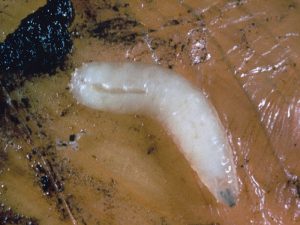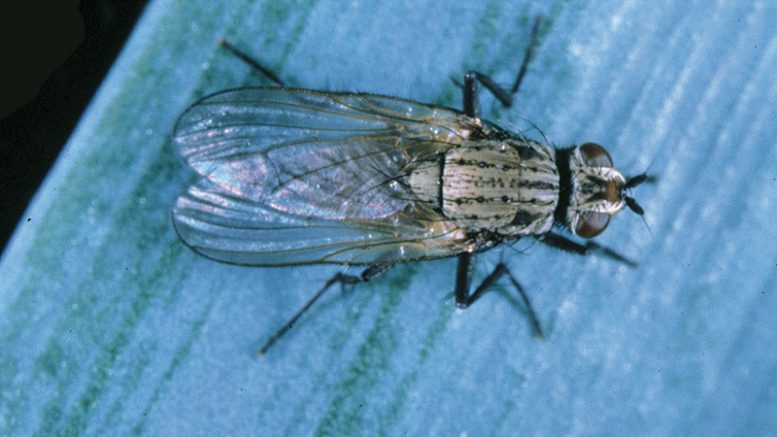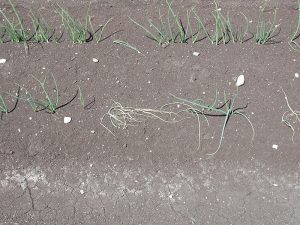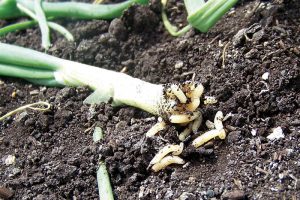Story by René Hardwick, National Onion Association
Photos courtesy Brian Nault, Cornell University
Much has been made about the common pesticide chlorpyrifos getting a second chance after it was banned earlier this year. The pesticide is commonly used throughout the U.S. onion industry to control onion maggots and seedcorn maggots. And for growers making decisions today about next spring’s pesticide needs, the on-and-off status of a ban on the pesticide is not the most welcome of threats.
In September, the U.S. Department of Justice requested a new hearing for the case in light of the pesticide being credited with protecting a large amount of America’s vegetable and fruit crops.
The ban came after a decade-long fight by environmental and public health groups to get the pesticide taken off the market because of concerns of health issues the pesticide had been associated with in children. At press time, there was no scheduled re-hearing to report.
U.S. Secretary of Agriculture Sonny Perdue said the ban appeared to be the result of “misunderstanding” and that the ultimate cost of a ban would be to the American farmer. The pesticide is used in more than 50 crops throughout the U.S.
“For some crops and target pests, chlorpyrifos is the only line of defense, with no viable alternatives,” Purdue stated.
Use in Onions
In terms of the U.S. onion industry, a ban of the pesticide will hit some worse than others. While a majority of onion growers must deal with thrips regularly, maggots are more of a problem in the northern tier of the country than the south.
Chlorpyrifos, commonly sold under the name Lorsban, has been an onion industry standard in controlling maggots since the mid-1980s when it was introduced.
But in the northern muck soils, the pesticide has become more of a sidekick to the onion superhero of insecticide seed treatments these days. In Washington down to northern California, the pesticide is commonly used to control seedcorn maggots. If there is an outright ban of the pesticide, there is an alternative in diazinon, developed in the mid-1950s, but application of that is much different than chlorpyrifos, said Tim Waters, regional vegetable specialist with Washington State University.
“Diazinon has to go on in advance of planting, and then you have to incorporate it into the soil,” he said.
Chlropyrifos can be put down the day of planting in-furrow with equipment on the planter and does not require a separate tillage operation to incorporate.
There are seed treatments onion growers can get, but they have to pre-order them well in advance of planting as they order their seed. This presents some logistical issues as they must decide before the season which cultivar will go in each field and if they anticipate a maggot issue. With chlorpyrifos, they can decide the day of planting if they need to utilize the insecticide.

Onion maggot larvae often enter the onion from the basal plate and feed inside the belowground portion of the onion plant for two to three weeks.
Resistance Concerns
Having alternatives to chlorpyrifos helps in more ways than one. Just as bacteria are growing resistant to antibiotics in humans, some bugs can develop resistance to pesticides, so having more in your onion arsenal than not may be the best way to move forward.
Brian Nault, a professor in the department of entomology at Cornell University, said chlorpyrifos started out in the East as the industry standard, but the pesky maggots it kept from boring into New York onions grew resistant. Farmers then used Lorsban in conjunction with a product called Trigard, an insecticide seed treatment for onions developed in 1996. The cocktail became the next industry standard for these growers until about six or seven years ago.
“Growers felt they didn’t get as good of control with Trigard alone as they did when they included Lorsban as a drench with the Trigard-treated seed,” Nault said.
In about 2011, Nault said, Syngenta came up with a breakthrough in a seed treatment package called FarMore FI500, which included a total of two insecticides and three fungicides.
“It worked beautifully well for controlling the onion maggot and the seedcorn maggot,” Nault said.
Maggots become a huge issue in northern muck soils because growers do not rotate their onion fields; they’re pretty much locked into the same fields every year as they’re really farming in drained swamps and lakes.
“For the onion maggot, that’s a dream come true,” Nault said. “They have three generations a year, and they’re not really good flyers. They just stay in the same field, complete their three generations, and next year, they don’t have to go very far.”
“That’s a worst-case scenario for growers in terms of managing onion maggots. The best thing you can do is rotate crops at least a half-mile away, but (many northern growers) are confined,” he explained.
Pesticide Preservation
Nault said pesticide use is a double-edged sword. When it works, it works, and growers tend to rely on it. When pests become resistant, the challenge is on to find more tools to fight them. To combat this problem, he recommends growers resort to alternating pesticides each year to confuse maggots’ systems.
Waters added, “That’s one of the reasons to preserve these different insecticides.”
Essentially, that means a ban of chlorpyrifos – which is exclusively used in the Pacific Northwest for maggot control in onion fields – would reduce those alternatives for pest control. If it is banned, it will likely mean a bigger hit to onion growers’ bottom lines, as newer insecticides are more expensive because they cost so much to develop.
To get a new active ingredient approved, according to the Western Farm Press, from 2010 to 2014, the average cost was $286 million and could take more than 11 years. In that article, Jesse Richardson of Dow AgroSciences said only one in 160,000 active ingredients would pass the requirements to become registered.
Waters said his phone has been lighting up in the last month because growers are wondering which way to go as they are being asked to buy their pesticides for the next growing season. Their biggest fear is buying something that will become illegal by the time they get it.



